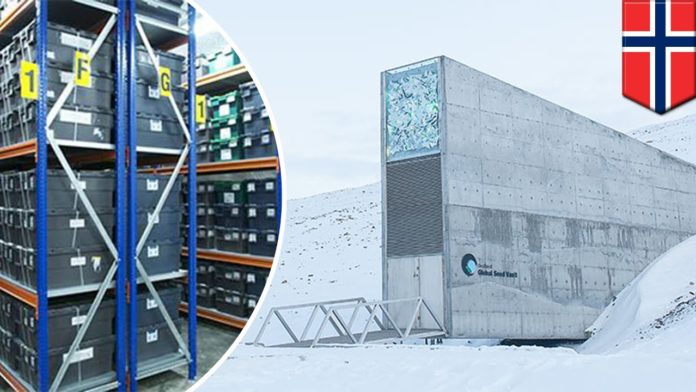The storage rooms are kept at −18 °C (−0.4 °F). The low temperature and limited access to oxygen will ensure low metabolic activity and delay seed ageing. The permafrost surrounding the facility will help maintain the low temperature of the seeds if the electricity supply fails.
What is the biggest seed bank in the UK? The largest seed bank is the Millennium Seed Bank Project, housed at the Wellcome Trust Millennium Building at Wakehurst, West Sussex, UK, which had more than 2.4 billion seeds, representing around 40,000 species, collected as of March 2021.
Then, How many seeds are in the Doomsday Vault? Each variety will contain on average 500 seeds, so a maximum of 2.5 billion seeds may be stored in the Vault. Currently, the Vault holds more than 1,000,000 samples, originating from almost every country in the world.
How cold is it at the Doomsday Vault? Inside the Doomsday Vault, temperatures are kept below minus 18℃, cold enough to keep the seed samples safe for at least 200 years, even without backup power.
FAQ
Where is the Doomsday Vault located?
Millions of these tiny brown specks, from more than 930,000 varieties of food crops, are stored in the Global Seed Vault on Spitsbergen, part of Norway’s Svalbard archipelago. It is essentially a huge safety deposit box, holding the world’s largest collection of agricultural biodiversity.
When was the Millennium Seed Bank built? The seed bank, opened in November 2000, and located at Wakehurst, Kew’s wild botanic garden in Sussex, acts as an ‘insurance policy’ for rare, threatened and useful plants, so that they can be protected for generations to come.
What is the largest seed in the world? Lodoicea maldivica, also known as the double coconut, or coco-de-mer, is renowned for producing the largest and heaviest seeds in the world.
Which is the smallest seed in the world? Orchids have the smallest seeds in the world and they produce millions of them, but why?
How long do seed vaults last?
For folks looking to store seeds for survival, seed vaults can be stored for a minimum of five years or more. The containers are compact, space saving, and waterproof. Most importantly, the seeds stored in seed vaults have been harvested from plants grown in diverse conditions.
Can you visit the Seed Vault? The world’s largest secure seed storage can be found in the permafrost close to Longyearbyen. The Global Seed Vault is not open for visitors, but you can join organized trips with guides that will take you close to the entrance.
Who owns Svalbard Seed Vault?
What groups are involved in the Svalbard Global Seed Vault? The Seed Vault is owned and administered by the Ministry of Agriculture and Food on behalf of the Kingdom of Norway and is established as a service to the world community.
Why is Svalbard seed vault under threat? The vault holds close to 900,000 seed samples in case of a global catastrophe. The home of the « Doomsday vault » – which stores the world’s most precious seeds in case of a global disaster – is under threat from climate change, scientists have warned.
Who owns the Svalbard Global Seed Vault?
The Seed Vault is owned and administered by the Ministry of Agriculture and Food on behalf of the Kingdom of Norway and is established as a service to the world community.
How long will the seed vault last?
To improve this crucial knowledge, a new seed longevity experiment, comprising seeds of 13 globally important crops, has started in the Svalbard Global Seed Vault. The experiment is planned to go on for 100 years.
Does the US have its own Seed Vault? « This is history in the making »: Cherokee Nation becomes first U.S. tribe to preserve culturally important seeds in Arctic « doomsday » vault. For more than a decade, the Svalbard Global Seed Vault — also known as the « doomsday » vault — has collected and maintained the world’s largest collection of diverse crops.
Does America have a Seed Vault? Participation in the Svalbard Global Seed Vault endeavor gave the United States a visible presence in the worldwide effort to safeguard the genetic diversity that underpins our food supply.
How old is the Millennium Seed Bank?
The world’s largest wild plant seed bank, home to some of our planet’s greatest natural treasures, celebrates 20 years since it was opened in November 2000.
Where is the largest seed bank? Way up north, in the permafrost, 1300 kilometers beyond the Arctic Circle, is the world’s largest secure seed storage, opened by the Norwegian Government in February 2008.
When did the seed bank start?
In the early twentieth century, scientists and agriculturalists collected plants in greenhouses, botanical gardens, and fields. Seed collection efforts in the twentieth century coincided with the professionalization of plant breeding.
Are coconuts seeds? Coconut is a seed because it is the reproductive part of the tree, coconut is a fruit because it is a fibrous one-seeded drupe and coconut is a nut because a loose definition of a nut is nothing but a one-seeded ‘fruit’.
What fruit has the smallest seed?
Maximum weight, in pounds, of the world’s largest known seed, in the fruit of the double coconut palm, Lodoicea maldivica. The smallest seeds in the world come from tropical orchids and weigh just 10 billionths of an ounce.
What’s the biggest fruit seed? The palm is best known for the seed of its fruit, which is the largest in the world, weighing in at 15 to 30 kg (33 to 66 lbs). The palm species was named maldvica after the Maldive Islands, the place the seeds were first found (before the 18th century the Seychelles islands were still uninhabited).























